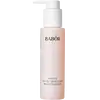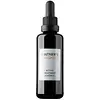What's inside
What's inside
 Key Ingredients
Key Ingredients

 Benefits
Benefits

 Concerns
Concerns

 Ingredients Side-by-side
Ingredients Side-by-side

Water
Skin ConditioningGlycerin
HumectantCaprylyl/Capryl Glucoside
CleansingButylene Glycol
HumectantPhenoxyethanol
PreservativeHydroxyethylcellulose
Emulsion StabilisingPanax Ginseng Root Extract
EmollientGinkgo Biloba Leaf Extract
Skin ConditioningSodium Citrate
BufferingCamellia Sinensis Leaf Extract
AntimicrobialParfum
MaskingEthylhexylglycerin
Skin ConditioningCitric Acid
BufferingBiosaccharide Gum-1
HumectantPotassium Sorbate
PreservativeMoringa Oleifera Seed Extract
Skin ConditioningMaltodextrin
AbsorbentSorbic Acid
PreservativeWater, Glycerin, Caprylyl/Capryl Glucoside, Butylene Glycol, Phenoxyethanol, Hydroxyethylcellulose, Panax Ginseng Root Extract, Ginkgo Biloba Leaf Extract, Sodium Citrate, Camellia Sinensis Leaf Extract, Parfum, Ethylhexylglycerin, Citric Acid, Biosaccharide Gum-1, Potassium Sorbate, Moringa Oleifera Seed Extract, Maltodextrin, Sorbic Acid
Aloe Barbadensis Leaf Juice
Skin ConditioningMalpighia Emarginata Fruit Extract
Skin ConditioningMoringa Oleifera Seed Extract
Skin ConditioningAlthaea Officinalis Root Extract
Skin ConditioningGlycyrrhiza Glabra Root Extract
BleachingCentella Asiatica Extract
CleansingUrtica Dioica Leaf Extract
Skin ConditioningGinkgo Biloba Leaf Extract
Skin ConditioningTaraxacum Officinale Root Extract
Skin ConditioningHelichrysum Italicum Extract
AntiseborrhoeicCamellia Sinensis Leaf Extract
AntimicrobialMedicago Sativa Leaf Extract
Skin ConditioningAstragalus Membranaceus Root Extract
EmollientVerbascum Thapsus
Skin ConditioningBacillus Ferment
Skin ConditioningLactic Acid
BufferingArginine
MaskingVinegar
Avena Sativa Bran Extract
AbrasiveNiacinamide
SmoothingGlycerin
HumectantTerminalia Ferdinandiana Fruit Extract
AntioxidantNelumbo Nucifera Extract
Skin ConditioningSaccharide Isomerate
HumectantPyrus Malus Fruit Extract
Skin ConditioningChlorella Vulgaris Extract
Skin ConditioningMaltodextrin
AbsorbentOriganum Majorana Leaf Extract
AntiseborrhoeicGluconolactone
Skin ConditioningMuriella Aurantiaca/Ruttnera Lamellosa Oil
Skin ConditioningLecithin
EmollientRuttnera Lamellosa Oil
Skin ConditioningWatanabea Reniformis Oil
Skin ConditioningSodium Ascorbate
AntioxidantSodium Hyaluronate
HumectantPapain
Skin ConditioningBromelain
Skin ConditioningArgemone Mexicana Callus Extract
AntioxidantMirabilis Jalapa Callus Extract
Skin ProtectingPolianthes Tuberosa Callus Extract
AntioxidantSodium Phytate
Sodium Hydroxide
BufferingLevulinic Acid
PerfumingSodium Levulinate
Skin ConditioningSodium Benzoate
MaskingPotassium Sorbate
PreservativeAloe Barbadensis Leaf Juice, Malpighia Emarginata Fruit Extract, Moringa Oleifera Seed Extract, Althaea Officinalis Root Extract, Glycyrrhiza Glabra Root Extract, Centella Asiatica Extract, Urtica Dioica Leaf Extract, Ginkgo Biloba Leaf Extract, Taraxacum Officinale Root Extract, Helichrysum Italicum Extract, Camellia Sinensis Leaf Extract, Medicago Sativa Leaf Extract, Astragalus Membranaceus Root Extract, Verbascum Thapsus, Bacillus Ferment, Lactic Acid, Arginine, Vinegar, Avena Sativa Bran Extract, Niacinamide, Glycerin, Terminalia Ferdinandiana Fruit Extract, Nelumbo Nucifera Extract, Saccharide Isomerate, Pyrus Malus Fruit Extract, Chlorella Vulgaris Extract, Maltodextrin, Origanum Majorana Leaf Extract, Gluconolactone, Muriella Aurantiaca/Ruttnera Lamellosa Oil, Lecithin, Ruttnera Lamellosa Oil, Watanabea Reniformis Oil, Sodium Ascorbate, Sodium Hyaluronate, Papain, Bromelain, Argemone Mexicana Callus Extract, Mirabilis Jalapa Callus Extract, Polianthes Tuberosa Callus Extract, Sodium Phytate, Sodium Hydroxide, Levulinic Acid, Sodium Levulinate, Sodium Benzoate, Potassium Sorbate
Alternatives
Ingredients Explained
These ingredients are found in both products.
Ingredients higher up in an ingredient list are typically present in a larger amount.
Camellia Sinensis Leaf Extract is derived from the leaves of the tea plant. Black tea, green tea, and oolong tea are all harvested from this plant.
This ingredient has many skin benefits:
This ingredient contains polyphenols, a strong antioxidant. Antioxidants help fight off molecules that damage skin cells.
On top of that, the antioxidants in green tea neutralize free-radicals from the sun. This gives the skin some extra UV protection, but should not replace sunscreen.
Many components of tea have anti-inflammatory properties.
Polyphenols and L-theanine help soothe the skin and reduce irritation. The caffeine in Camellia Sinensis Leaf Extract helps calm inflamed blood vessels.
Other compounds found in tea include: Vitamin Bs, linoleic acid, magnesium, calcium, iron, and zinc.
Research has shown both drinking Camellia Sinensis Leaf Tea and applying it to the skin can help boost skin elasticity and hydration. Studies also show using tea extract may reduce sebum, or oil, production.
Learn more about Camellia Sinensis Leaf ExtractGinkgo Biloba Leaf Extract comes from the leaves of the Ginkgo tree. It has soothing and antioxidant properties.
The leaves of ginkgo contains flavonoids and terpenoids, potent antioxidants. Antioxidants may protect your skin from damage caused by external sources such as pollution.
Its soothing ability comes from a variety of compounds including biflavones, a type of flavonoid. Studies show gingko biloba has strong anti-inflammatory properties.
Fun fact: This tree is native to China and has been used in traditional Chinese medicine for thousands of years.
Learn more about Ginkgo Biloba Leaf ExtractGlycerin is already naturally found in your skin. It helps moisturize and protect your skin.
A study from 2016 found glycerin to be more effective as a humectant than AHAs and hyaluronic acid.
As a humectant, it helps the skin stay hydrated by pulling moisture to your skin. The low molecular weight of glycerin allows it to pull moisture into the deeper layers of your skin.
Hydrated skin improves your skin barrier; Your skin barrier helps protect against irritants and bacteria.
Glycerin has also been found to have antimicrobial and antiviral properties. Due to these properties, glycerin is often used in wound and burn treatments.
In cosmetics, glycerin is usually derived from plants such as soybean or palm. However, it can also be sourced from animals, such as tallow or animal fat.
This ingredient is organic, colorless, odorless, and non-toxic.
Glycerin is the name for this ingredient in American English. British English uses Glycerol/Glycerine.
Learn more about GlycerinMaltodextrin is a polysaccharide. It is derived from starch such as rice, corn, wheat, or potato starch.
In food, Maltodextrin is used to improve the texture and thicken a product. Due to its structure, it can help create a gel texture. As an emulsion stabilizer, it helps keep the ingredients in a product together.
As a polysaccharide, Maltodextrin has moisturizing properties. Polysaccharides are a type of carbohydrate. The top layer of skin uses polysaccharides to retain water, keeping the skin hydrated.
Maltodextrin is water soluble and has a sweet taste.
Learn more about MaltodextrinMoringa Oleifera Seed Extract comes from the seeds of the Moringa oleifera plant.
Moringa seeds have antioxidant, anti-inflammatory, and skin hydrating properties. These seeds are rich in oils, proteins, monounsaturated fats, and tocopherols.
As an emollient, moringa seed oil helps trap moisture in the skin by creating a film on top. This helps keep your skin hydrated and soft.
Many compounds in moringa seed oil are antioxidant and anti-inflammatory. These compounds include Vitamin E. , catechins, ferulic acid, and more.
Another compound found in Moringa seed oil is oleic acid.
Moringa trees are native to the Himalayan mountains.
Learn more about Moringa Oleifera Seed ExtractPotassium Sorbate is a preservative used to prevent yeast and mold in products. It is commonly found in both cosmetic and food products.
This ingredient comes from potassium salt derived from sorbic acid. Sorbic acid is a natural antibiotic and effective against fungus.
Both potassium sorbate and sorbic acid can be found in baked goods, cheeses, dried meats, dried fruit, ice cream, pickles, wine, yogurt, and more.
You'll often find this ingredient used with other preservatives.
Learn more about Potassium Sorbate